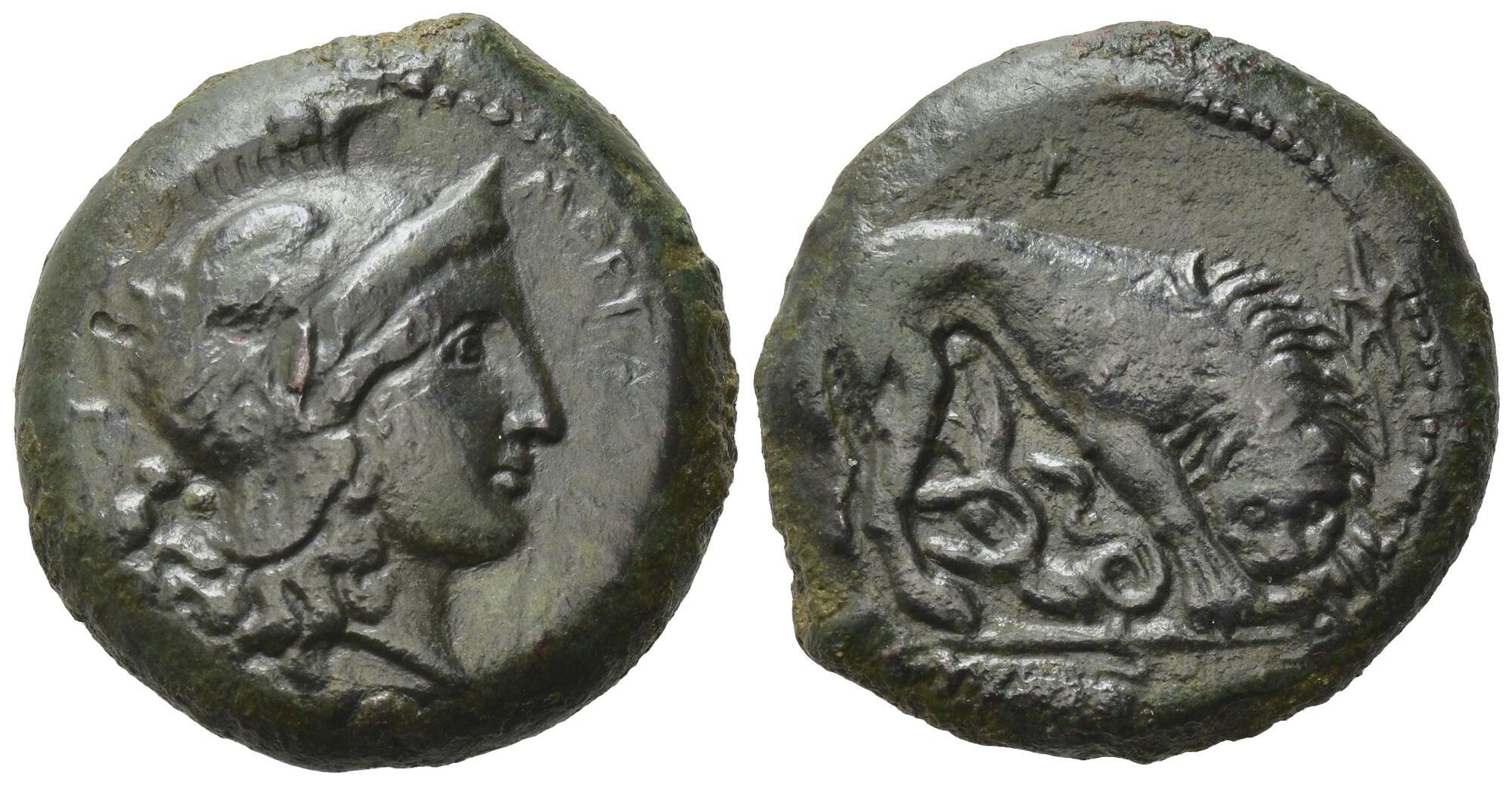Morgantina, bronze, litrai (Athena/lion) (339-317 BCE)
From SILVER
344 BCE - 317 BCE Bronze
Description
| ObverseInscription or printing placed on the obverse.: | MOPΓANTINΩN (Greek).Head of Athena right, wearing triple crested helmet decorated with serpent and spiral, retrograde Γ behind |
| ReverseInscription or printing placed on the reverse.: | Lion r., tearing at stag's head, serpent below, Γ above |
Mint and issuing power
| MintIdentifies the place of manufacture or issue of a numismatic object.: | Morgantina | Ancient regionAncient region.: | Sicily | Modern countryModern country: Italy | AuthorityIdentifies the issuing power. The authority can be "pretended" when the name or the portrait of X is on the coin but he/she was not the issuing power. It can also be "uncertain" when there is no mention of X on the coin but he/she was the issuing power according to the historical sources: |
Chronology
| FromIdentifies the initial date in a range assigned in a numismatic context. | 344 BCE | toIdentifies the final date in a range assigned in a numismatic context.. | 317 BCE | PeriodTime period of the numismatic object.: Classical and Hellenistic |
Physical description
| MetalThe physical material (usually metal) from which an object is made.: | Bronze |
Median weightMedian of the weights of numismatic objects (in grams). in grams | 18.40 | DenominationTerm indicating the value of a numismatic object. Examples: tetradrachm, chalkous, denarius.: | litra |
StandardStandard.: | |
| Mode weightMode of the weights of numismatic objects (in grams).: | 18,40-9<ul><li>No units of measurement were declared for this property.</li> <!--br--><li>",40-9" is not declared as a valid unit of measurement for this property.</li></ul> |
Image

H 32 - Morgantina, bronze, litra, 344-317 BC.jpg [1]
References
| Die study referencePublication of the study: | Buttrey 19891Buttrey 1989, Group III, B (6) | ||
| Coin series referenceReference to coin series study: | HGC 22HGC 2, n° 903 | ||
Obverse dies distribution
| FrequencyFrequency of specimen in distribution. ᵖ | Number of obversesNumber of obverse dies. ᵖ (o) | % (o) | Number of coinsNumber of coins. (n) | % (n) | Die nameName(s) of the die(s). |
| 14 | 1 | 33.33 | 14 | 21.21 | 2 |
| 15 | 1 | 33.33 | 15 | 22.73 | 1 |
| 37 | 1 | 33.33 | 37 | 56.06 | 3 |
| Total | 3 of 3 | 99.99 | 66 of 66 | 100 |
Reverse dies distribution
no distribution is available
Quantification
| Number of obversesNumber of obverse dies. ᵖ (o) | 3 | Number of singletons (o1)The number of singleton coins. ᵖ | |
| Number of reverse diesNumber of reverse dies. (r) | 7 | Number of coinsNumber of coins. (n) | 66 |
| Coins per obverse dieNumber of coins per obverse die. (n/o) | 22 | Coins per reverse dieNumber of coins per reverse die. (n/r) | 9.43 |
| Reverse per obverse ratioRatio of obverse dies divided by reverse dies. (r/o) | 2.33 | Percentage of singletons (o1)number of coins (n) divided by the number of singletons (o1) ᵖ | % |
| Original number of dies (O) (Carter 1983 formula)The estimation of the number of coins according to Carter 1983 ᵖ | 2.91 | Coins struck if 20,000 as average productivity per dieCoins made if the average productivity for obverses (according to Carter) is 20,000. ᵖ | 58,200 |
| Original number of dies (O) (Esty 2011 formula)The estimation of the number of coins according to the singleton formula in Esty 2011 ᵖ (O) | 3.14 | Survival rate if 20,000 as average productivity per dieSurvival rate if average productivity is 20,000. ᵖ | 0.00113 |
| Coverage (o = % of O) (Esty 1984 formula)Esty 1984 - coverage (% of O) ᵖ (o = % of O) | % | Die productivity if survival rate 1/2,000Average productivity if survival rate is 1/2,000. ᵖ | 45,360.82 |
| Weight of silver (in kg) if 20,000 coins per die (O = Carter formula)Carter 1983 * Median weight * 20000 (*10 if gold or electrum) ᵖ | n.a. | Die productivity if survival rate 1/5,000Average productivity if survival rate is 1/5,000. ᵖ | 113,402.06 |
Remarks
References
- ^ Buttrey, Theodore V. et al. (1989), Morgantina Studies, vol. II: The Coins, Princeton, 1989, xx, 245 p., 49 pl., 29 cm
- ^ Hoover, Oliver D. (2012), The Handbook of Greek Coinage Series. 2. Handbook of the Coins of Sicily (Including Lipara). Civic, Royal, Siculo-Punic, and Romano-Sicilian Issues. Sixth to First Centuries BC, Lancaster-London, 489 p.